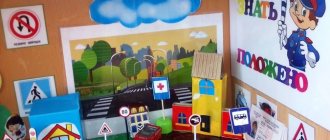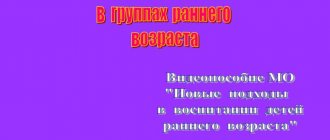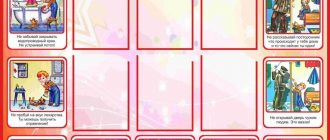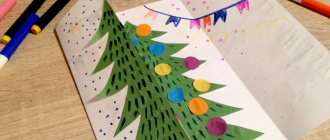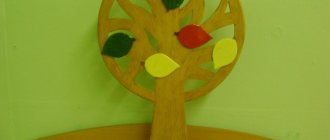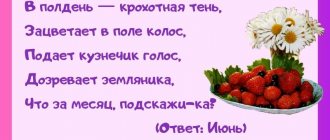MAGAZINE Preschooler.RF
Report “Requirements for organizing a speech corner in a group of preschool educational institutions”In modern preschool education, speech is considered as one of the foundations of raising and educating children, since the level of speech determines the success of children’s education at school, the ability to communicate with people and general intellectual development. The developmental environment and communication are factors that determine speech development. Today we will look at one of the centers of the subject-development environment - the Speech Corner. It is a specially equipped space for playing alone or in small groups.
The purpose of the speech corner: to promote the creation of optimal conditions for organizing a subject-development environment in a group to improve the process of development and correction of children’s speech.
Tasks:
- Formation of phonemic perception and hearing.
- Development of articulatory motor skills.
- Strengthening the skills of correct pronunciation of sounds.
- Consolidation of skills acquired in classes.
- Activation of vocabulary, generalizing concepts and lexical and grammatical categories.
- Development of coherent speech.
- Development of fine motor skills.
Its equipment includes shelving located at different levels, a table, a chair, gaming, didactic and visual material that stimulates speech activity and verbal communication in children.
When selecting the components of a speech corner, it is necessary to take into account:
- correspond to the individual and age characteristics of children;
- the speech corner should be placed next to the book corner;
- It is important that the speech corner is comfortable and aesthetically pleasing. Beauty shapes a child. Therefore, it is necessary to pay great attention to the aesthetics of the speech corner. Its design should be attractive to children and arouse their desire for independent activity. At the same time, it is necessary to teach children to maintain order and cultivate a caring attitude towards materials and equipment contained in the corner;
- gaming material must be accessible to the child;
- An integral attribute of the speech corner should be a toy - an “animate character” , an ordinary doll, a bi-ba-bo, a puppet. Such a toy should be multifunctional. She can move (with the help of an adult or child), perform articulation exercises, ask or answer questions, ask riddles, come up with interesting stories, present unexpected surprises and much more. Her abilities will arouse keen interest in children and encourage speech activity.
- Do not overload the corner with equipment.
The speech corner is based on gaming and didactic material aimed at developing:
articulatory motor skills (object support pictures; articulatory patterns; articulatory gymnastics in albums for a specific sound; articulatory gymnastics in poetry and pictures; cotton swabs, cotton pads)
aids for the development of breathing (colorful balls; plumes; paper snowflakes; pinwheels - pencils; foil bells on a string, etc.)
aids for the development of fine motor skills (dry pool; massage rollers, balls, clothespins, stencils; finger games; various materials for composing letters)
material on onomatopoeia (noise instruments; sound boxes; children's musical instruments: piano, accordion, drums, pipe, tambourine, rattle, bells, rattles; subject, plot pictures for expressing sounds and their automation; sounds of vowels and consonants (houses for hard and soft sounds); individual manuals for sound-letter analysis; word diagrams; sound tracks, sound ladder; albums on the syllabic structure of words)
games and aids for automating sounds (small toys; object pictures; plot pictures; various types of theaters; albums for each sound; speech therapy albums for automating various sounds; tongue twisters, poems, nursery rhymes, tongue twisters; sound characteristics diagram; word diagram)
games on vocabulary and grammar (subject pictures on lexical topics)
games for the development of coherent speech (series of plot pictures; different types of theater; tongue-twisters, poems, nursery rhymes, tongue twisters; library of children's books, etc.)
literacy materials - (magnetic board; sets of magnetic letters; cash registers of letters and syllables; cubes “ABC in pictures” , “Learn to read” , “Smart cubes” , “Syllable cubes” ).
The content of the speech corner is determined not by chance, but in strict accordance with the program, physiological and psychological characteristics of the formation of children’s speech.
The selection of gaming and didactic material is carried out jointly by the speech therapist and educator, which makes their interaction not formal, but very close and fruitful.
Requirements for the content of speech centers in different age groups
Junior group
- Book corner 5-6 titles of books, 2-5 copies each, since children of this age are characterized by imitation, screen books (we select books taking into account the age of the children, namely, for this age, works of Russian folklore: ditties, nursery rhymes, songs, folk tales about animals, works of Russian and foreign classics, stories, fairy tales, poems by modern authors);
- Albums or illustrations on the topics “Toys” . “Family, “Transport” , “Pets” , “Clothing” , “Dishes” , “Furniture” .
- Pictures with simple plots and actions
- Didactic games for the formation of vocabulary, vocabulary, grammatical structure of speech, coherent speech.
- Didactic games for grouping, classification, series like “What’s extra?” , . ”
- Games like “Find a pair” , “Find the differences” .
- Game visualizers, toys - phones.
- Games with object pictures like “What has changed?”
- Pictures with a simple plot for writing stories.
- Albums of riddles, tongue twisters, songs, nursery rhymes, poems.
- Stencils, templates.
- Games for developing manual skills.
- Card index of speech games.
- Postcards about your hometown.
Middle group
- Book corner: 5-6 titles, for decoration you can use prints on the themes of Russian folk tales. Once a quarter it is necessary to organize thematic exhibitions “Fairy Tales” , “Seasons” , “Tales of Animal Friendship” , etc.
- The albums are supplemented by topics about the Russian army, the work of adults, wild animals, flowers, vegetables, fruits, and the seasons about various buildings (architecture).
- Postcards for viewing.
- Portraits of writers according to the program
- Didactic games for grouping, classification, series like “What’s extra?” , . ”
- Fable games “What in the world doesn’t happen?” , "Who's screaming?"
- Games with pictures - riddles and subject pictures like “What has changed?” "Find a match?" , "Find differences" .
- Didactic games for the formation of vocabulary, vocabulary, grammatical structure of speech, coherent speech.
- Game visualizers, phone toys, entertaining puzzles.
- Albums of riddles, tongue twisters, tongue twisters, poems.
- Stencils, templates for preparing your hand for writing
- Games to develop manual skills.
- Card index of verbal speech games.
- Postcards about your hometown, region.
- Household and antique items.
Senior group
- Book corner 7-8 books of various subjects and genres (maybe books of the same title, but illustrated by different artists). Once a quarter, thematic exhibitions with children’s drawings on a given topic are organized
- Portraits of writers according to the program
- Albums or illustrations are supplemented with information about the Motherland and technology.
- Books based on children's drawings on themes from works by children's writers.
- Portraits of artists - illustrators.
- Didactic games for the formation of vocabulary, vocabulary, grammatical structure of speech, coherent speech, in preparation for learning to read and write.
- Games - fables, games - pictures like “Name the differences” .
- Sets of pictures “Make a story from the picture” , “Put them in order and make a story” .
- ABC of letters of different textures.
- Albums of riddles, tongue twisters, tongue twisters, poems.
- Stencils, punched cards, templates for preparing your hand for writing
- Games to develop manual skills.
- Card index of verbal speech games.
- Collection of badges, stamps, calendars, labels.
- Didactic material for depicting letters (ropes, laces, wire, pebbles, sand, plasticine, etc.).
- Blanks for shading, coding, stencils, punched cards.
- Sets of letters of different colors, sizes, materials, sound rulers, syllabic rulers.
- Illustrations about monuments and museums of antiquity (Moscow, St. Petersburg).
- Map of Russia, where cities are marked with flags.
Preparatory group for school
- Availability of a library of books by section: about nature, about animals or by author. 10-12 books are exhibited, varying in genre and subject matter. Thematic exhibitions with children's drawings are organized.
- Albums or material about the work and life of writers.
- Albums of riddles, tongue twisters, poems.
- Blanks for shading, coding, stencils, punched cards for preparing the hand for writing, games for developing manual skills.
- Card index of verbal speech games.
- Collection of badges, stamps, calendars, labels.
- Didactic material for depicting letters (ropes, laces, wire, pebbles, sand, plasticine, etc.).
- Sets of letters of different colors, sizes, materials, sound rulers, alphabet letters of different textures.
- Didactic games for the formation of vocabulary, vocabulary, grammatical structure of speech, teaching children to read and write.
- Games - fables “What did the artist mix up?” , games - pictures like “Find the differences” .
- Sets of pictures “Make a story from the picture” , “Put them in order and make a story” .
- Albums or books are homemade with children’s creations and drawings.
- Corner “Read ourselves” magazines “Fidget” , “Funny Pictures” , “Sunny Bunny” , etc., children's colorful books with large print, books with educational tasks.
| Next > |
Making a speech corner with your own hands
The speech development center is equipped and staffed in accordance with the age of the pupils. Thus, every year it is transformed and enriched to make it interesting and productive for children to study here.
For younger preschoolers, the speech development corner may include a sensory area - a place for the development of fine motor skills. As an option, this is a table with educational games: pyramids, a sorter, books and toys with buttons, bags for seeds and pebbles.
In the speech corner of the younger group, you can arrange a table with games for the development of sensory perception
Or it’s a rug on the wall with beepers, rubber bands, a plastic mirror, buttons, felt pictures, ribbons, and Velcro. The sensory mat usually depicts the plot of a fairy tale familiar to children (“Turnip”, “Teremok”, “The Three Little Pigs”) or images of natural objects, animals: flowers, trees, butterflies, birds, bunnies, etc. Everyone knows that a child’s first he actually wants to touch the object that interests him, so a developmental rug is made from pieces of bright fabric, scraps of velvet, printed ribbon, and colorful braid.
Fun images on the rug attract children and encourage active sensory perception of textile images
In recent years, busy boards have become popular as equipment for sensory development - boards or stands with objects attached to them, which small children are usually forbidden to touch. It is easy to make a business board with your own hands: various locks (latch, door hook, latch), bicycle and door bells, buttons and switches are glued or screwed onto a plywood sheet.
The development of sensory perception and fine motor skills is facilitated by the study of the so-called. "busy boards"
For all age groups of preschoolers, objects and play sets for the development of speech breathing should be presented in the corner. For these purposes, waste material and simple toys are used: plastic tubes and cups, ping-pong balls, cotton balls, plumes and pinwheels, flags, balloons. The teacher includes breathing exercises in play activities: “Put the ball into the goal”, “Raise the sails!”, “Shallow, shallow, mill!”.
Simple materials were used to create the game: cardboard, colored paper and cotton balls.
In the speech corner of the senior and preparatory groups, a place is set up for board and printed games. The selection is made up of games with letters and words:
- “Entertaining ABC”: for cards with letters (uppercase and printed), you need to select cards with images of objects for these letters.
- “ABC Lotto”: cards with beeches are filled with chips with animals whose names begin with these letters.
- “Kaleidoscope of Letters”: children learn to recognize the symbolic designations of letters on the playing field.
- “Make a word. Dominoes: cards are used to create an image and its name.
- “Who lives where”: cards with words, animals and their habitats.
Such games teach children to add syllables and words, as well as develop speech abilities in group play.
To stimulate children's verbal creativity and play dramatization games, a small area with a screen, decorations, and dolls is set up in the corner. Unlike the theatrical activity corner, the space for performances in the speech corner is limited. For example, you can cover a cardboard box - it will be a fairy-tale forest for the figurines. Dialogue using hand puppets and bibabo can be acted out from behind a folding paper screen.
Dolls and decorations stimulate children's independent speech creativity
Requirements for the speech development corner according to the Federal State Educational Standard for Preschool Education
- Optimal location: the corner is sufficiently lit, located in a quiet place next to the book, theater and sensory development corners.
- Compliance with the age and individual needs of children.
- The presence of an animated character - a doll or toy. The character who owns the corner encourages children to engage in speech activity: he tells funny stories, invites them to play, and asks questions. With the help of an animated toy, motor exercises and articulatory gymnastics are demonstrated.
- Aesthetics. The corner is designed in the same style as the areas for artistic reading and theatrical activities. The place of study attracts not only with bright colors, but also with interesting objects: reproductions on the wall, figurines on the shelf. Didactic and gaming materials are located in a corner by topic, and students learn to maintain order.
- Safety. Pupils of the first and second junior groups independently practice the development of fine motor skills under the supervision of a teacher (due to the danger of small parts getting into the respiratory tract). It is not recommended to equip the speech corner with hanging shelves or cabinets with glass doors. Electrical appliances and power supplies must be out of the reach of children.
Speech corner design option - video
An example of designing a speech corner in the middle group - video
Speech Corner Passport
A kindergarten corner passport is an information document that describes the state of the activity center, equipment and subject content. The passport is drawn up by the teacher and certified by the administration of the preschool educational institution, stored in the teacher’s document folder or in a special cell in the corner. Colleagues, young professionals, and parents of students can get acquainted with information about the contents of the corner. A passport is required to nominate a corner for a competition of pedagogical projects to organize a subject-development environment for children.
Sample speech corner passport template:
- Name of the corner, age group.
- Tasks of the corner (briefly).
- Furniture items, quantity.
- Electrical appliances, if any (audio player, projector).
- List of visual teaching aids (posters, mnemonic tables).
- List of demonstration materials (thematic pictures, cards-schemes).
- Didactic and board games.
- Sets for breathing exercises and dramatization games.
- Card file of speech exercises and games.
Fragment of the passport of the corner for speech development: visual, didactic and demonstration materials - table
| Stories from pictures (visual teaching aid) | • Winter 1. • Spring 1. • Summer 1. • Autumn 1. • Professions 1. |
| Demo material | • Wintering and nomadic birds 1. • Pets 1. • Tell us about kindergarten 1. • Dishes 1. • Wild animals and their young 1. • Family 1. • Fruits 1. • Vegetables 1. • Cards-drawings of special-purpose machines 1. • Cards-drawings on the theme, seasons, fairy tales, clothes 1. |
How to name the corner of speech development
The name of the developmental activity corner in kindergarten should be short and understandable. Traditionally, the activity center is named after the actual focus of the activity. Since a mandatory attribute of a speech corner is an animated toy, the name of this fantasy character is often used in the name. Unusual and funny names arouse additional interest among students. You can arrange a competition for children and parents to come up with a name.
- Classic names: “Speech Corner”, “Speech Coach”, “Speech Development Corner”, “Learning to Talk”, “Speech Development Lessons”.
The traditional name reflects the direction of development of children's abilities in the corner
- Titles with the name of the owner of the corner: “Lessons of Aunt Owl”, “Hello, Dunno!”, “Visiting Luntik”, “Button Invites”, “Talker”, “Mushka the Talker”, “Bunny the Lopotushka”.
The corner is named after an animated character - the hare Govorushi
- Funny names: “Let's Talk”, “Gazebo”, “Zvukarik”, “Govoryashka/Govorusha”, “Azbukvarik”, “ABVGDEyka”, “Govorilki”, “Logostrana”, “Let’s Sit and Talk”, “Rechetsvetik”.
Funny names attract children to explore the corner
Speech Corner Design Tools
The corner is organized in the group’s premises with the aim of developing children’s speech abilities and, by its design, encourages pupils to express opinions, joint discussions, and conversations. Both children and their parents are involved in drawing posters, wall newspapers and pictures.
Plates and emblems - photo gallery
Signs for all corners of the group can be made according to a single template
A favorite character can be depicted on the sign to attract children's attention.
The sign is attractive and creates a positive mood for activities in the corner
The plate contains the original name of the corner and an image of its owner
Plates and emblems with the name of the corner are a mandatory design element: they indicate the direction of educational activities, contain the name and sometimes an image of a character beloved by children. It would be aesthetically sound to make a plate in the same style for all activity zones in a group, or to maintain uniformity in the logos of speech development centers.
Pictures - photo gallery
The drawings can represent animated characters that give children speech exercises
Images of fairy-tale characters decorate the walls of the corner
Pictures based on a children's favorite fairy tale serve both as a corner decoration and as materials for constructing a story.
The pictures indicate one of the areas of work of the speech corner - familiarization with letters and sounds
Pictures and drawings decorate the walls and furniture in the group room. To design the speech development corner, images of fairy tale and cartoon characters, animals, and letters are used. At the same time, the pictures in the speech corner are functional; children can be asked a question about them or come up with a task aimed at developing oral speech: “Who is shown in the picture? Describe what he is like,” “Say hello to Dunno. Tell him how your day was,” “Come up with a short story based on this picture,” etc.
Stand - photo gallery
A stand with plastic cells is suitable for displaying information for parents and picture diagrams for children.
At the stand, the teacher places didactic
Work in the speech development corner
Classes in the speech corner are built within the framework of the leading activity of preschoolers - play. That is why it is necessary for the teacher to have a toy assistant; inclusion in the play situation occurs as soon as the character greets the children. Children often have to be encouraged to engage in speech activity. The teacher arouses in the pupils interest in conversation, using topics close to the children (“Our toys”, “What do you like to do on a walk”, “What fairy tales did your parents read to you”, “What do you want to become”, etc.).
Games and exercises in the speech development center are aimed at developing abilities and correction. The corner is used during a frontal speech lesson (with the whole group). But more often, individual and subgroup classes are held here, since there is a tendency to reduce speech therapy groups and the teacher is required to carry out continuity with the work of a speech therapist.
Table: types and forms of activities in the speech corner
| Kind of activity | Form of activity |
| Subgroup lesson |
|
| Individual | Individual classes in the speech corner are conducted with children whose monitoring has revealed a low level of speech development, and with those who have been assigned additional classes by a speech center specialist.
|
| Independent activity |
|
Speech games in kindergarten - video
Games for the development of verbal communication in a nursery group - video
Articulation gymnastics for children - video
Dramatization game in the first junior group - video
Regular classes in the speech corner help create a positive emotional atmosphere within the children's team and form sustainable motivation for active and cultural communication. Success in the future directly depends on the level of development of the child’s speech. A rich vocabulary, confidence in formulating thoughts, poems memorized by heart, knowledge of proverbs and sayings, and expressive speech indicate a high intellectual level of a preschooler.
